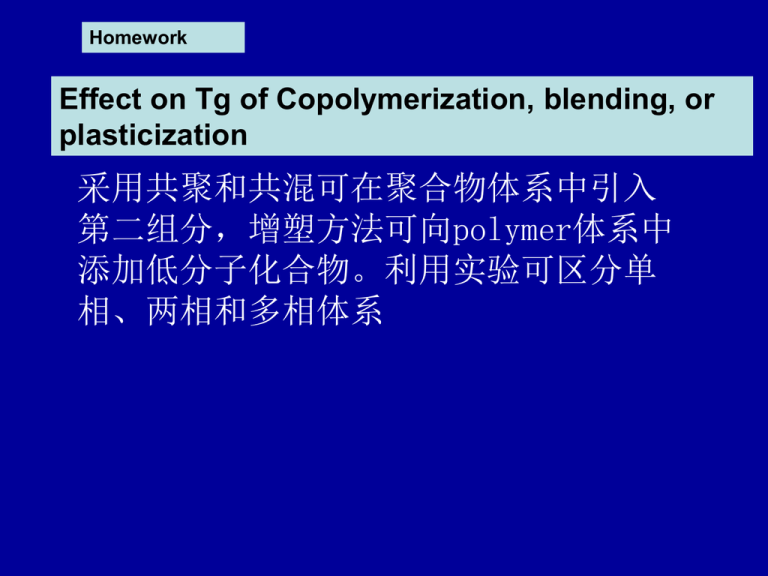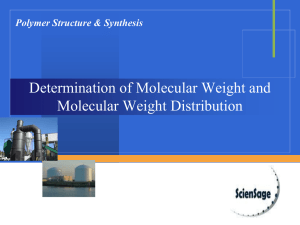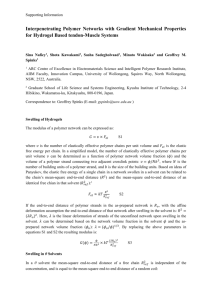溶化过程 - 高分子物理
advertisement

Homework Effect on Tg of Copolymerization, blending, or plasticization 采用共聚和共混可在聚合物体系中引入 第二组分,增塑方法可向polymer体系中 添加低分子化合物。利用实验可区分单 相、两相和多相体系 One-Phase Systems 单相体系(只有一个Tg) Miscible polymer blends, random or alternative copolymers, and plasticized system 如何预测Tg(因为Tg处于两组分之间)? Fox equation 下限 Linear eguation 上限 Glass-transition temperatures of poly(2,6-dimethyl-1,4phenylene oxide)-blend-polystyrene (PPO/PS) blends versus mass fraction of PPO Two-Phase Systems 两相体系(有两个Tg) Immiscible polymer blends, as well as their related graft and block copolymers and interpenetrating polymer networks Each phase will exhibit its own Tg The intensity of the transition, especially in the loss spectra (E"),is indicative of the mass fraction of that phase Dynamic mechanical behavior of polystyrene-block-polybutadienepolystyrene ,a function of the styrene-butadiene mole ratio Effect on Tg of Crystallinity 结晶度的影响 形 变 轻度结晶聚合物 M1 M2 结晶聚合物 M 2 M1 Tg T f Tm 图 晶态和非晶态聚合物的温度形变曲线 温度 Semicrystalline polymers such as polyethylene or polypropylene or of the nylon types also exhibit glass transitions, though only in the amorphous portions of these polymers. The Tg is often increased in temperature by the molecular-motion restricting crystallites Sometimes Tg appears to be masked, especially for high crystalline polymers Effect on Tg of Pressure 压力的影响 Since an increased pressure causes a decrease in the total volume, an increase in Tg is expected based on the prediction of decreased free volume Kf为自由体积的等温压缩系数 ∆K为Tg上下的压缩系数差 Glass transition versus pressure for various substances Pressure coeffcients of the glass transition temperatures selected materials 以上结果表明,增加压力可导致材料 的玻璃化。这对工程操作例如模压和 挤出十分重要,在Tg(105Pa)附近操 作可使材料硬化 这样就有玻璃化转变压力的术语。另外,玻璃化转 变分子量、玻璃化转变浓度(对于稀溶液和增塑)。 还有外界条件的影响。广义上,玻璃化转变具有多 维性 3.6 Thermodynamics of Crystallization and Fusion 结晶和熔融热力学 一.高分子晶体与低分子晶体的熔化过程的比较: 物质从结晶状态转变为液态的过程成为熔融。 低分子比容与T关系:熔 化过程是一级相转变,发 生在非常窄的温度之内 (0.2K左右) 突变 比 容 Tm T 比 容 Tm 熔 限 Dilatometric behavior of polymer melting 高结晶 polymer的比容—— 温度关系:1、边熔化边升 温,突变不明显 2、存在熔 限——较宽的熔融温度范围 的3-4K 结晶polymer的熔融过程是不是热力学一级相转变? 所谓一级相转变熔化过程中,体系自由能对温度 和压力P的一阶导数发生不连续变化,转变温度与保 持平衡的两相的相对数量有关,按照热力学的定义, 这种转变通过做实验可以证明。 对许多高聚物精心测量,每变化一个温度eg:升 1 ℃ , 维持恒温,直到体积不再变化 (24hr) 后再测比容,结果过 程十分接近跃变过程,在终点处出现明确的转折——是热力 学的一级相转变。 只有程度的差别而无本质的差别。 结晶Polymer边熔融边升温的现象? 熔点:晶体全部熔化完了的温度。 是由于结晶 聚合物 中含有完善程度不同的晶体的缘故。 结晶时随着T ↓ η↑分子链活动能力减小,还不及作充分的位置 调整,这样各个不同阶段结晶状态同时并存,当熔化不完善的晶 体(分子链堆不紧密)将在较低的温度下熔融, 而完善的晶体 则在较高温度下才能熔融,所以在通常升温条件下便出现较宽 的熔融温度范围。 二. 测定Tm的方法 依据在突变时polymer 的各种物理性质发生 变化:密度.折光指数.热容.透明性等。 (1)膨胀计-------比容-Tm (2)DTA:利用结晶熔融过程发生的热效应大 的特点测Tm (3)DSC法:测定热效应 经验规则:计算 估计 对称的polymer Tm=2Tg(K) 不对称的polymer Tm=1.5Tg(K) (因 polymer的结晶和熔化都是通过链段的运动来实现) 三、Effect on Tm Differential scanning calorimetric curve of a semi-crystalline polymer 可用下列热力学函数关系描述: ΔG=ΔH-TΔS<0 对于结晶过程,∆H<0(结晶放热),有利于∆G<0, 但∆S<0,即链段规整排列使熵变小,不利于∆G<0。 对于熔化过程 由晶态转变到熔融态 由于熔化过程吸热ΔH>0,这是不利 于ΔG<0 的因素,同时熔化过程链段排列变的无序化,ΔS>>0, -TΔS 成了有利于ΔG<0 的因素, 显然T↑, 越有利于熔融的进 行. 在 Tm处,晶相与非晶相达到热力学平衡即: ΔH------ 1 mol 重复单元的熔化热,表示分子或链段离开晶格 所需吸收的热量,与分子间作用力强弱有关 ΔS-----相应的熔化熵标志着熔融前后分子混乱程度的变化, 与分子链的柔顺性有关. 当ΔS一定时 分子间作用力越大ΔHm ↑ , Tm↑ 当ΔH一定时 链的柔性越差 ΔS↓ , Tm ↑ 凡是影响到分子间作用和链的柔顺性的因素都会影 响Tm 这就是我们讨论影响Tm因素的核心 影响Tm的因素 1、Effect of Chemical Structure on the Melting Temperature High melting points are associated with highly regular structures 规整性 rigid molecules 刚柔性 close packing capability 堆砌性 strong interchain attraction 分子间作用力 A、Regularity Polyester Tm℃ 265 220 规整性越高,熔点越高 B、Flexibility Polyester Tm℃ 50 265 刚性越大,熔点越高 C、Interchain force Polyester Tm℃ 170 240 增加高分子或链段之间的相互作用,即在主链或侧基 上引入极性基团或氢键,可使ΔH 增大Tm ↑ 作用力越大,熔点越高 聚酰胺(聚氨基酸)的熔点随重复单元碳原子 数的增加而降低。另外奇数或偶数碳原子影响分 子链堆砌的规整性。 聚脲、聚酰胺、聚氨酯、聚酯、PE 它们熔点趋势如图: 300 解释: (1) Tm 的高低顺序 (2)随着它们的重复单元的增加趋 近与 PE的熔点(可用生成物质 分子间氢键和氢键的密度说明) 聚脲 聚酰胺 200 聚氨酯 100 线型聚乙烯 聚酯 0 14 18 22 26 聚酰胺形成分子间氢键与重复单元中碳原子奇偶数的关系 A 偶数的氨基酸;B 奇数的氨基酸;C偶酸奇胺;D偶酸偶胺 当主链含有双键时,链柔性好,rubber的Tm都很低 NR Tm(℃) 28 POM 180 PE 137 PTIF 327 说明ΔH和ΔS是从两个方面描述分子链的性 质,因此不可分割,共同其作用。单在不同条件 下,两者的主次作用不同。 D、Packing capability E、Melting Point Depression in the presence of impurities杂 质存在下的熔点降低 The melting point depression in crystalline substances from the pure state is given by the general equation(Flory) a:the activity of the crystal (活度) (1)Copolymer X: the mole fraction A : crstallizable fraction B :non-crstallizable fraction (杂质,即分子链中非结晶 共聚单体的摩尔分数) XB很小时 共聚破坏了高分子链的规整性,使得Tm下降 Conclusion: 无规共聚—降低均聚物的Tm,改善加工性能 嵌段共聚—聚合物熔点降低极少,改善其弹性 (SBS) 交替共聚—大幅度降低聚合物的Tm (2)End group端基 —Influence of molecular weight M0-the molecular weight of the end mer Mn-the number-average molecular weight 该式说明分子量越大,Tm越高,分子量无限大时,Tm最高 (3)Solvent or Plasticizer溶剂或增塑剂 V1——the molar volume of the solvent Vu——the molar volume of the polymer repeat unit υ1——the volume fraction of diluent Χ1——the Flory solvent interaction parameter. 在结晶聚合物中加入少量的增塑剂,防老剂、或者结晶性 高聚物的单体与少量另一种单体无规共聚时Tm下降 F、Crystalline-Amorphous Polymer Blend The above discussion relates primarily to addition of low-molecularweight species to a high-molecular-weight polymer. When the added species is also polymeric, quite different analytical relationships hold, because of the reduced entropy of mixing. According to the Flory-Huggins approximation: 1 1 R1 2 0 (1 2 ) Tm Tm H m 2 1—the amorphous polymer 2—the crystalline polymer υ2——the volume fraction 1 ——the Flory solvent interaction parameter Equation describes the melting point depression due to mixing of a crystalline polymer with an amorphous polymer The important point is the role played by . 1 If 1 is negative , the melting point depressions can be realized If 1 is positive, mixtures of two polymer will be in phase separation . In the case of a crystalline-amorphous polymer blend, phase separation would not be expected to result in large melting point depressions eg: PVF crystallizes, and it is totally miscible with PMMA. In fellow Figure Tm depression of PVF is shown 1 0.295 Determination of the thermodynamics of polymer blending by melting point depression for poly(vinylidene flouride)-blend-poly(methy methacrylate) G、Other factors relating to the Melting Point 影响熔点的其他因素 Thickness of the lamellae(晶片厚度l) Tm°-晶片厚度为∞的晶体的熔点 σe-表面能 ∆H-单位体积的熔融热 Crystallization temperature(结晶温度, Tc) Tc-结晶温度 Υ-与结构有关的参数 Pressure(压力, P) Stress(应力)……











